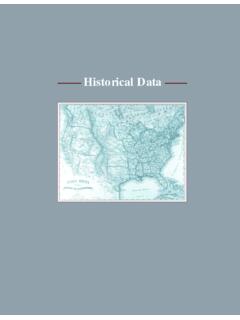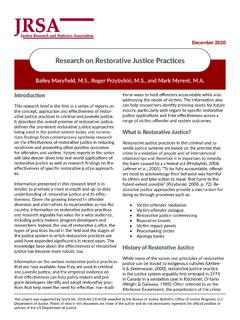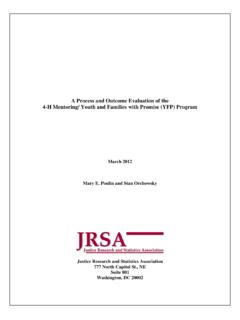Transcription of Historical Data - Justice Research and Statistics Association
1 Historical Data 33 Historical Data34 Crime and Justice Atlas 2000 The arrival of the new millennium provides an opportunity to reflect on the past andconsider the challenges of the future. The 20th century saw remarkable changes inthe administration of Justice , and the 21st century will undoubtedly bring a host ofnew issues and challenges. As Justice decisionmakers and administrators consider these fu-ture issues, it is helpful to look at the past for clues as to what the new century may the National Data and State Data components of the Crime and Justice Atlas 2000, weexamine statistical trends over the past 20 25 years in law enforcement, sentencing, andcorrections. This Historical Data section examines long-term trends that span the betterpart of the 20th century.
2 Whereas short-term trends can show patterns in crime, arrest rates,sentencing, and correctional populations, long-term trends can reveal cycles in these rates,and can demonstrate how they are connected to social conditions and societal appears to be a pattern in the short-term can be seen as part of a larger cycle whenexamined over many more years. Long-term trends can show us more clearly where we havebeen so that we can have a better understanding of where we may be two-page graphs included in this section depict long-term trends in crime, arrests, andcorrections. Each graph is accompanied by text that highlights the key changes shown inthe graph. The first graph shows the index crime rate for the 66-year period from 1933 to1998.
3 Index crimes are reported by local law enforcement agencies to their states and ulti-mately to the Federal Bureau of Investigation, which publishes the data as part of its Uni-form Crime Reporting (UCR) program. Since index crimes are considered to be the mostserious of crimes, their aggregate gives a good indication of how the crime rate has changedover the latter two thirds of the second display shows the long-term trend in the most serious of crimes, murder. Whilemurder is infrequent relative to other index crimes, it is often the type of crime that attractsthe most public attention. The graph shows the murder rate from 1900 through 1998. Thesedata are not from law enforcement agencies, since the national UCR program was not initi-ated until 1930.
4 Instead, the data come from the Centers for Disease Control and Prevention sNational Center for Health Statistics (NCHS). NCHS, through the National Vital Statis-tics System, collects information on causes of death from death certificates. While thesedata are not generated by the Justice system, they are an accurate indicator of the long-termtrends in this most serious of more than any other crime type, drug crimes are affected by societal attitudes andjustice system policies. The late 1960s and early 1970s, for example, was a period of relativepermissiveness toward drug use, especially marijuana use. The mid-1980s saw the introduc-tion of crack cocaine, along with the federal government s declaration of a war on drugs.
5 The response of local, state and national law enforcement agencies to these changes inpolicies and social mores is reflected in part in changes in arrest rates for drug sales andpossession. The third display depicts the drug arrest rate for the 34-year period from 1965to 1998. The display also focuses on the last 20 years to show the components of the largertrend (sale vs. possession, marijuana vs. cocaine/crack and heroin). The trends shown heresuggest that the use of illegal substances will continue to be a major challenge for the justicesystem for the foreseeable to Historical DataLong-term trends can showus more clearly wherewe have been so that wecan have a betterunderstanding of wherewe may be Data 35 Over the last century, changes in policies and procedures in one area of the Justice systemhave had clear impacts on other components of the system.
6 The fourth display shows thetrend in the size of the prison population from 1925 to 1997. These data were compiled bythe Bureau of Justice Statistics and are based on reports from states of their prison popula-tions as of the end of each year. A number of factors contribute to the trend shown in thegraph, including crime trends, law enforcement activities, sentencing policies and proce-dures, and policies regarding release and fifth display shows the 70-year trend in releases from prison, from 1926 through graph shows changes in both conditional releases, comprising mainly discretionaryreleases to parole supervision, and unconditional releases, comprising mainly releases as aresult of expiration of sentence.
7 The number of releases from prison is clearly connected tothe number of admissions to prison, since for much of the century most states did not havethe capacity to house large numbers of prisoners for long periods of time. The changingnature of releases, however, may be the result of more modern sentencing and parole poli-cies and of the more contentious issues in the United States in the 20th century is capital pun-ishment. States have varied greatly in their policies regarding the execution of criminals,and policies and attitudes within individual states, and the nation as a whole, have changedover time. The final display juxtaposes the number of offenders who were held in prisonsunder sentence of death from 1953 to 1998 with the number of prisoners executed between1930 and 1999.
8 These two graphs illustrate dramatically how social values may be reflectedin Justice system policies, and the implications of these policies for Justice system managersand taken as a whole, these Historical displays provide some indication of how the justicesystem has responded to the problem of crime and criminals over the last 100 years. Justicesystem managers and decisionmakers will find this information useful as they attempt tomeet the challenges posed by criminal activity in the 21st the last century,changes in policies andprocedures in one areaof the Justice systemhave had clear impactson other componentsof the Crime and Justice Atlas 2000 Changes in the overall incidence of crime are most often measured by examining theindex crime rate, which includes the reported crimes of murder/nonnegligent manslaughter,rape, robbery, aggravated assault, burglary, larceny, and motor vehicle theft.
9 The re-ported crime rate was fairly level during the 1930s, 1940s, and 1950s, before sharplyincreasing until the early 1970s. Although the crime rate plateaued during the last quarterUnited States Index Crime Rate, 1933 1998 Dollar limit for larcenyis removed; measure-ment change resultsin rate increaseper 100,000 population02,0004,0006,00019631958195319 48194319381933 Historical Data 37of the century, the rate has dropped and climbed by as much as 900 crimes per 100,000population over the last 20 years. The United States is currently in the midst of thelongest period of decline over the entire period shown, with a 1998 crime rate of 4,615per 100,000 population, the lowest since 1973, when the rate was 4, rate peaksat 5,9501991 Second highof 5,898 Source: Uniform CrimeReports, 1933 1998,Federal Bureau Crime and Justice Atlas 2000 Across the country, and even internationally, the murder rate receives more atten-tion than any other crime rate.
10 The trend chart below shows the murder rate as arecurring flow of sustained increases and decreases spread over the 20th century. Therate increased through the early 1900s, peaking in 1933 at murders per 100,000population. The rate then decreased until 1960, followed by a sharp increase until theUnited States Murder Rate, 1900 1998036912194919421935192819211914190719 001914 1918 World War Iper 100,000 population1930sGreat Depression1939 1945 World War IIHistorical Data 39 Source: Vital Statistics , Na-tional Center for Health Statis-tics. The 1998 data, which arepreliminary, are from Birthsand Deaths: Preliminary Datafor 1998, Vol. 47, No. 25, The murder rate fluctuated over the last 25 years at a historically highlevel, as did the overall index crime rate, but has declined rapidly during the murder rate in 1998, the last full year of available data, hit a 30-year low of per 100,000 population.















